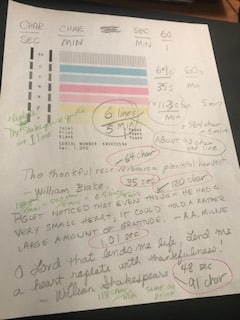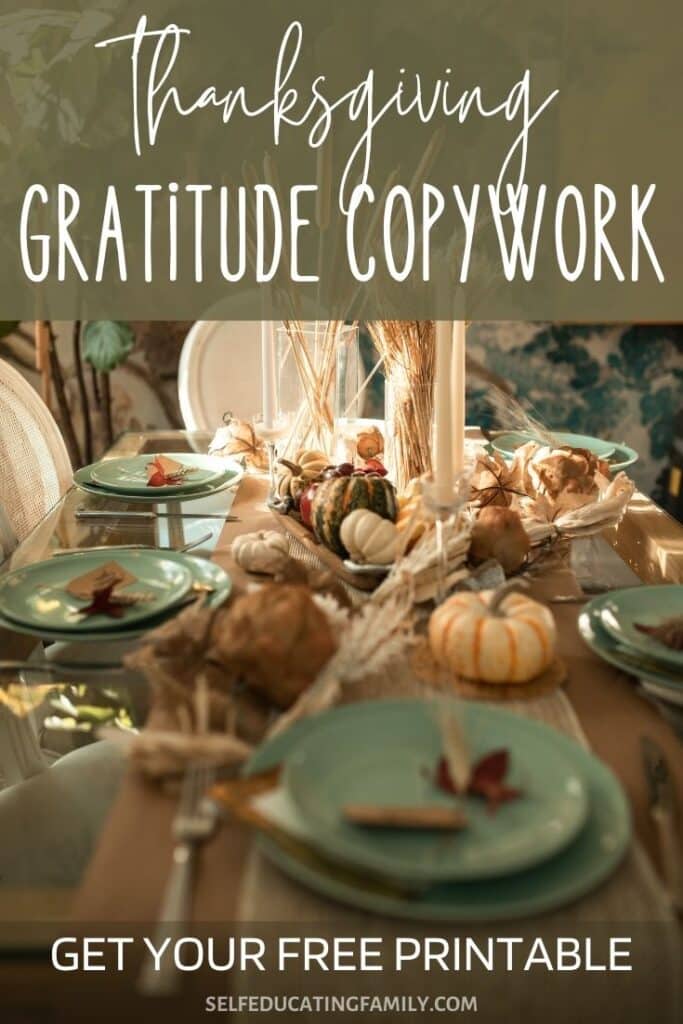What’s inside: Copywork Tips, especially for learners who are more advanced, in the older forms, or have achieved fluency (ease) and are working towards mastery (proficiency). You’ll also find some great Thanksgiving & Gratitude themed copywork from poetry and folk songs.
First, a bit of background… or you can skip right to the copywork!
Why copywork?
When you make copywork selections from beautiful writing, then your child benefits in so many ways! Copywork can be a valuable tool for homeschoolers:
- To learn language arts:
- grammar
- spelling
- sentence structure
- penmanship
- writing style
Copywork Principles
- Use selections from Living Books
- Short lessons: 5 to 15 minutes max
- “6 perfect strokes”
- Compare and correct your work when finished
Rule 1 for Copywork: Source from Living Books
The key to great selections is to use living books as the source for your copywork – that way you’ll expose your young learner to great examples of language. Of course, you can “cheat” by using copywork by someone who has already found super sources for you! Like the free Thanksgiving copywork printable at the bottom or this post.
Eventually, your children will make their own selections from the books they are reading. While they are young, you will want to supervise the selections or help make selections for them.
Rule 2 for Copywork: Keep it SHORT!
Charlotte Mason homeschoolers rely on copywork from living books coupled with short lessons. 5-15 minutes is plenty in your homeschool day. You are running a marathon, not a sprint!
I think the short lessons are super important when we are talking about copywork because you want to make sure the child is giving full attention and not just sloppily going through the motions.
Which brings us to “6 perfect strokes”…
Rule 3: “6 perfect strokes”
“6 perfect strokes” are better than a page of messiness. In other words, executing handwriting well is superior to sloppily learning or learning to form letters incorrectly. “Perfect strokes” means excellence, not perfectionism.
This concept comes from Charlotte Mason’s approach to copywork:
No work should be given to a child that he cannot execute perfectly… Set him six strokes to copy; let him, not bring a slateful, but six perfect strokes, at regular distances and at regular slopes.
Charlotte Mason
The child will grow and be able to do more within the 5-15 minutes as time goes on and they develop fluency.
Rule 4: Child Learns to Evaluate
The child should compare and correct his work when finished. Teach your youngest children how to do this, and by the time they are ready to do copywork with dictation, they’ll have independence in evaluating their work. Self-learners in the making!
When teaching them to self-evaluate you can ask these questions, and eventually, they’ll ask the questions of themselves. Evaluation should be brief.
- Are the letters evenly spaced and uniform?
- Do they touch the baseline and the correct top lines?
- Are the ascenders and descenders of the proper height?
- Do they have the same slant (especially cursive)?
Advanced evaluation
Evaluation doesn’t mean all negative. Nor is it about perfectionism.
I like to use the “Sandwich” method of evaluation, which we learned in our speech club.
In a public speaking club, you want to be encouraging especially to novice speakers. As all the speakers are evaluated on the spot, the trick we taught to evaluators (who were also novice speakers) was the “sandwich” method of evaluating: Say something positive, then offer a single fixable criticism, then mention finish something done well. The fixable skill to work on is sandwiched between 2 positive things. This avoided the crushing evaluations where dozens of things that stunk were harped on.
How does this apply to copywork and self-evaluation?
Example
Here’s a sample copywork I did to time how long it actually takes to do copywork if you have achieved mastery.

I tried different styles – print, cursive, and all caps (because all caps happens to be my preferred style of handwriting, and so I’m fastest at that) – and if I were to critique it, this is what I would say:
“Nice overall. My lines slope upwards on the paper (I was using unlined, blank scrap paper) – I start off straight with the first quote, but the other two start going way upwards at the end of the lines. But it’s neat and readable.” (And this is despite my scrawling of notes and computations all over the page!)
Now it took me much longer to type that out than say it. So nothing fancy, just a quick observation.
The next time I copy something I might work on my sloping lines. Then the critique would include, “I was working on keeping my lines orthogonal to the paper edges, and it was much better.” or “I still need more work there.”
So the sandwich method helps the evaluation to be balanced and focused. It’s much better to be working on one thing at a time than “All my letters STINK! I can’t stand this!”
Tip: Keep a sample of your child’s copywork from the beginning and end of each semester. That way, you can show them that they are improving.
Wait, you timed it?
Yes, I timed myself doing some copywork to see how easy or hard it was. I wanted some frame of reference for what is a good length for copywork.
I mean, I can say “short lessons” of 5 minutes, but how much copywork should I expect my kid to do in that amount of time?
Here was my experiment:
- I selected 3 gratitude quotes: Blake, Milne, & Shakespeare. (B,M, & S)
Insert gallery



- I wrote one in print, one in cursive, and one in small caps. I timed each one.
- Then I did some math. It was important to keep in mind “units” for these calculations.
- I counted #characters per quote.
- B = 65 char/quote
- M = 91 char/quote
- S = 120 char/quote
- Timed each quote in seconds:
- B = 35 sec/quote
- M = 48 sec/quote
- S = 61 sec/quote
- Math to get each quote in minutes using 60 seconds per minute
- B = 113 char/min
- M = 113 char/min
- S = 118 char/min
- I realized that characters per minute is not what I wanted. I wanted approximate lines of type per minute so that I could look at a quote and know how long it might take. So I averaged the characters per line in all three quotes and they were all about 90 characters per line.
- Then I realized I wanted to know if 5 minutes was a good time for a quote, so I needed to find how many lines per 5 minutes I could copy.
- They all came out to about 6 lines in 5 minutes.
- I counted #characters per quote.
Conclusion
- So a one-line quote that I can copy in a minute or so, should be a fine amount for a learner who is working on fluency to complete in 5 minutes.
How long should copywork selections be?
For learners just starting, 5 minutes is plenty. Copywork is an everyday subject. Like math, a little bit each day helps to recall and improve how to do it.
And as learners move through the stages of copywork, they might work up to 15 minutes.
What if they haven’t finished copying?
It’s fine to come back to the same copywork the next day, even if they are in the middle of a sentence. The next day, have them quickly review (evaluate) where they were and move along to the next word.
Really long selection for Thanksgiving Copywork
To demonstrate the ability to stop in the middle of copywork, I’m giving you a really long Thanksgiving copywork selection: it’s the full text of Edgar Albert Guest’s poem Gratitude.

I can copy this in just under 10 minutes, and my hand gets tired by the end. So I’d expect my copyworkers to do it in 3 days of 5 to 10 minutes each. But it depends on the child and how much handwriting they do – if they’ve been doing copywork regularly for years, their hands probably don’t get tired! Nowadays, I type more than handwrite!
Free Thanksgiving Copywork
When you sign up for the newsletter, you can download this Gratitude Poem copywork for free!
SelfEducatingFamily.com needs the contact information you provide to us to contact you about our products and services. You may unsubscribe from these communications at anytime. See our privacy policy for terms and conditions and to learn how we protect your data.
Gratitude
by Edgar Albert Guest
Be grateful for the kindly friends that walk along your way,
Be grateful for the skies of blue that smile from day to day,
Be grateful for the health you own, the work you find to do,
For round about you there are men less fortunate than you.
Be grateful for the growing trees, the roses soon to bloom,
The tenderness of kindly hearts that shared your days of gloom,
Be grateful for the morning dew, the grass beneath your feet,
The soft caresses of your babes and all their laughter sweet.
Acquire the grateful habit, learn to see how blessed you are,
How much there is to gladden life, how little life to mar!
And what if rain shall fall to-day and you with grief are sad,
Be grateful that you can recall the joys that you have had.
FAQ
If you do copywork regularly (3-5 times a week), it shouldn’t take more than 15 minutes. So, you could try 5 minutes if you are just starting out, or if you have not achieved fluency in your letterforms.
🦃 Edgar Albert Guest’s poem Gratitude is excellent for copywork. The repetition of the phrase “Be grateful” evokes thoughtful copying.
🦃 Another great poem is A Thanksgiving Poem by Paul Dunbar which gives a feeling of humble thankfulness in another era.
Keep Learning
Copywork:
Thanksgiving:











